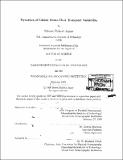| dc.contributor.advisor | Jochem Marotzke. | en_US |
| dc.contributor.author | Jayne, Steven Robert | en_US |
| dc.contributor.other | Woods Hole Oceanographic Institution. | en_US |
| dc.date.accessioned | 2012-02-24T18:57:13Z | |
| dc.date.available | 2012-02-24T18:57:13Z | |
| dc.date.copyright | 1999 | en_US |
| dc.date.issued | 1999 | en_US |
| dc.identifier.uri | http://hdl.handle.net/1721.1/69203 | |
| dc.description | Thesis (Sc. D.)--Joint Program in Physical Oceanography (Massachusetts Institute of Technology, Dept. of Earth, Atmospheric, and Planetary Sciences; and Woods Hole Oceanographic Institution), 1999. | en_US |
| dc.description | Includes bibliographical references (p. 161-169). | en_US |
| dc.description.abstract | A state-of-the-art, high-resolution ocean general circulation model is used to estimate the time-dependent global ocean heat transport and investigate its dynamics. The north-south heat transport is the prime manifestation of the ocean's role in global climate, but understanding of its variability has been fragmentary owing to uncertainties in observational analyses, limitations in models, and the lack of a convincing mechanism. These issues are addressed in this thesis. Technical problems associated with the forcing and sampling of the model, and the impact of high-frequency motions are discussed. Numerical schemes are suggested to remove the inertial energy to prevent aliasing when the model fields are stored for later analysis. Globally, the cross-equatorial, seasonal heat transport fluctuations are close to +4.5 x 1015 watts, the same amplitude as the seasonal, cross-equatorial atmospheric energy transport. The variability is concentrated within 200 of the equator and dominated by the annual cycle. The majority of it is due to wind-induced current fluctuations in which the time-varying wind drives Ekman layer mass transports that are compensated by depth-independent return flows. The temperature difference between the mass transports gives rise to the time-dependent heat transport. The rectified eddy heat transport is calculated from the model. It is weak in the central gyres, and strong in the western boundary currents, the Antarctic Circumpolar Current, and the equatorial region. It is largely confined to the upper 1000 meters of the ocean. The rotational component of the eddy heat transport is strong in the oceanic jets, while the divergent component is strongest in the equatorial region and Antarctic Circumpolar Current. The method of estimating the eddy heat transport from an eddy diffusivity derived from mixing length arguments and altimetry data, and the climatological temperature field, is tested and shown not to reproduce the model's directly evaluated eddy heat transport. Possible reasons for the discrepancy are explored. | en_US |
| dc.description.statementofresponsibility | by Steven Robert Jayne. | en_US |
| dc.format.extent | 169 p. | en_US |
| dc.language.iso | eng | en_US |
| dc.publisher | Massachusetts Institute of Technology | en_US |
| dc.rights | M.I.T. theses are protected by
copyright. They may be viewed from this source for any purpose, but
reproduction or distribution in any format is prohibited without written
permission. See provided URL for inquiries about permission. | en_US |
| dc.rights.uri | http://dspace.mit.edu/handle/1721.1/7582 | en_US |
| dc.subject | Joint Program in Physical Oceanography. | en_US |
| dc.subject | Earth, Atmospheric, and Planetary Sciences. | en_US |
| dc.subject | Woods Hole Oceanographic Institution. | en_US |
| dc.title | Dynamics of global ocean heat transport variability | en_US |
| dc.type | Thesis | en_US |
| dc.description.degree | Sc.D. | en_US |
| dc.contributor.department | Joint Program in Physical Oceanography | en_US |
| dc.contributor.department | Woods Hole Oceanographic Institution | en_US |
| dc.contributor.department | Massachusetts Institute of Technology. Department of Ocean Engineering | |
| dc.identifier.oclc | 45234104 | en_US |
